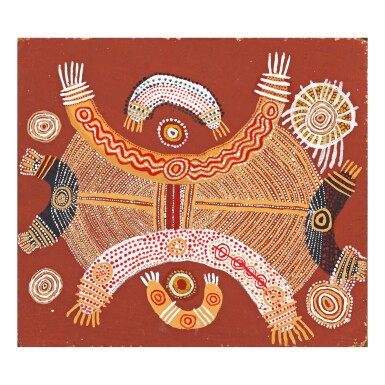
UTA UTA TJUNGALA | UNTITLED (TWO BOYS' DREAMING - BOYS; HAIRPIECE DREAMING)
Auction Closed
December 13, 10:40 PM GMT
Estimate
30,000 - 50,000 USD
Lot Details
Description
Property from the Collection of Fiona Brockhoff
UTA UTA TJUNGALA
CIRCA 1920-1990
UNTITLED (TWO BOYS' DREAMING - BOYS; HAIRPIECE DREAMING)
Natural earth pigments and synthetic polymer paint on composition board
18 in by 17 ¾ in (45.5 cm by 45 cm)
Purchased directly from the artist at Papunya in June-July, 1972
Mr. and Mrs. W.L. Jackson, Victoria
Sotheby's, Melbourne, Important Aboriginal Art, 28 June 1999, lot 74
Fiona Brockhoff, Melbourne
National Gallery of Victoria, Melbourne, Origins of Western Desert Art: Tjukurrtjanu, 30 September 2011 - 12 February 2012
Musée du quai Branly, Paris, 9 October 2012 - 20 January 2013
Geoffrey Bardon and James Bardon, Papunya, A Place Made After the Story: The Beginnings of the Western Desert Painting Movement, The Miegunyah Press, Melbourne, 2004, p. 498, painting 485 (illus.)
Judith Ryan and Philip Batty et al., Origins of Western Desert Art: Tjukurrtjanu, Melbourne: Council of Trustees of the National Gallery of Victoria, 2011, p. 145 (illus.)
In the first two years of the Papunya painting movement, the school teacher Geoffrey Bardon, a prominent catalyst for the formation of the men’s painting group, commissioned a number of artists to paint pictures that were suitable for children to see. The resulting paintings by Tim Payungka Tjapangati, Mick Namarari Tjapaltjarri, Anatjari No. III Tjakamarra and Long Jack Philllipus Tjakamarra feature recognizable figures of ancestors in human form. Other paintings feature the symbolic iconography of desert graphic art to depict scenes of initiatory activities where boys are shown undergoing instruction in the laws of the desert peoples.
Uta Uta Tjangala’s Untitled (Two Boys' Dreaming - Boys; Hairpiece Dreaming) belongs to the latter category. The painting depicts two boys, symbolized by the centrally located and decorated U-shapes in the upper and lower registers of the painting, sitting astride camp fires depicted as roundels. In between is an elaborate representation of the ceremonial hairpieces. The arced form in the lower section bears a Water Dreaming design formed by three roundels linked by parallel meanders of dotted and solid lines. A ground mosaic is depicted in the lower left corner.
In the initiation ceremonies of the Pintupi, novices receive a yiruwarra or yakirri, a red headband denoting manhood. John Kean, the manager of Papunya Tula Artists between 1977 and 1979, describes Uta Uta Tjangala as invariably carrying two spears and a spear-thrower and wearing 'a red-ochred hair-string or red woollen yakirri'.1 This would suggest the painting is possibly autobiographical in nature.
The painting was originally acquired directly from the artist at Papunya in June or July 1972 by Mr and Mrs W. L. Jackson who worked alongside Geoffrey Bardon at the Papunya school. During May and June, Bardon was effectively banned by the settlement’s administrator from selling paintings to the Stuart Art Centre, in Alice Springs, and with no outlet, the artists were forced to resort to sell paintings to the few interested parties in the Papunya Community.
Wally Caruana
[1] John Kean in Judith Ryan and Philip Batty et al., Origins of Western Desert Art: Tjukurrtjanu, Council of Trustees of the National Gallery of Victoria, Melbourne, 2011, p. 126.
